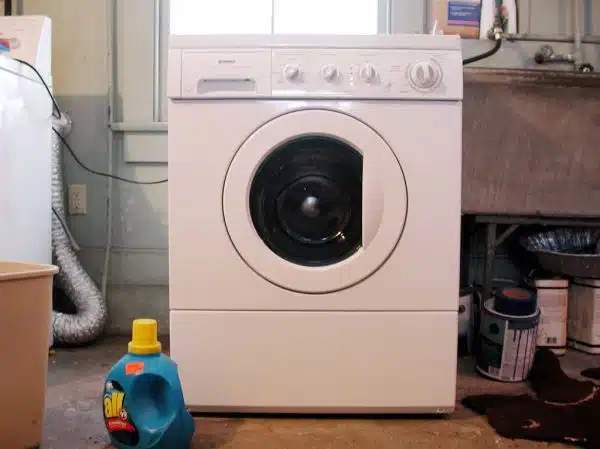Moving a washer and dryer can be a daunting task, especially if you are not familiar with the process. It requires careful planning and execution to ensure that your appliances are moved safely and securely to your new location. As a moving expert, I have helped numerous individuals and families successfully move their washers and dryers without any damages.
One of the most important things to consider when moving your washer and dryer is their weight. These appliances can be heavy and difficult to move, which is why it is crucial to have the right tools and equipment on hand. Additionally, you need to take certain precautions when disconnecting them from their power source or water supply. In this article, I will provide you with some tips and tricks on how to move your washer and dryer safely and efficiently so that you can enjoy a hassle-free relocation experience.
Assessing Your Moving Situation
Before you move your washer and dryer, it is essential to assess your moving situation. Measuring the space where your appliances will go in your new home is the first step. You need to know if they will fit in the designated area and if there are any obstacles that need to be removed before you move them in.
If you have trouble measuring or moving large appliances, consider hiring professionals. A moving company or appliance installation company can help you with this task. They can measure your new space and ensure that the appliances will fit. Moreover, they have specialized equipment to move heavy items safely.
Taking time to assess your moving situation before relocating your washer and dryer can save you time, money, and stress. Remember that preparation is key to a successful move. In the next section, we will discuss how to prepare your appliances for moving.
Preparing The Appliances For Moving
Assessing your moving situation is a crucial step in ensuring a smooth and successful move. Once you have determined that moving your washer and dryer is necessary, it’s time to start preparing them for the move. This involves measuring the space in your new home and picking the right moving company.
Measuring space is important because washers and dryers come in different sizes, and you need to be sure that they will fit into the designated space in your new home. Before you start packing up your appliances, measure the width, height, and depth of both units. Take note of any doors or hallways that may pose an obstacle during the move. This information will be helpful when choosing a moving company.
Picking the right moving company can make all the difference when it comes to transporting your appliances safely to their new location. Look for a company that has experience with appliance moves and has positive reviews online. Make sure they are licensed and insured to protect yourself from any potential damages during transit. With these steps in mind, you can ensure that your washer and dryer arrive at their destination without any issues.
3 Tips for Preparing Your Washer and Dryer for Moving
- Clean both units thoroughly before packing them up. This will help prevent any mold or mildew growth during transit.
- Disconnect all hoses and wires from both appliances before moving them.
- Secure both units with heavy-duty straps or bungee cords inside the moving truck to prevent any shifting or damage during transport.
With these tips in mind, you can feel confident in preparing your washer and dryer for a successful move.
Moving can be stressful, but with proper planning and preparation, it doesn’t have to be overwhelming. In the next section, we’ll discuss how gathering necessary tools and equipment can help streamline the process of preparing your washer and dryer for transportation.
Gathering The Necessary Tools And Equipment
To move a washer and dryer, it is essential to gather the necessary tools and equipment. Choosing appropriate attire is vital to ensure safety during the moving process. Wearing closed-toe shoes with non-slip soles can prevent slipping and tripping accidents while carrying heavy appliances.
Renting a moving truck is also necessary for transporting these appliances. It is crucial to choose a truck that is large enough to accommodate both the washer and dryer comfortably. Before renting a truck, measure the dimensions of the appliances to ensure they will fit in the vehicle.
Moving heavy appliances requires effort, but with proper planning and execution, it can be done safely. The next step after gathering the necessary tools and equipment is disconnecting the power supply from the washer and dryer.
Disconnecting The Power Supply
As you prepare to move your washer and dryer, it’s important to gather the necessary tools and equipment for the job. Think of this step as gathering your supplies before embarking on a camping trip: you need everything in one place so that you’re ready for any situation that may arise during the move. Some essential tools include a dolly or hand truck, moving straps or rope, and moving blankets or towels to protect the appliances from scratches and dings.
Now that you have all of your tools and equipment ready, it’s time to focus on disconnecting the power supply. This is a crucial step in ensuring safety during the move. Common mistakes people make when disconnecting their washer and dryer include forgetting to unplug them from the wall or turning off the power source at the circuit breaker. Before doing anything else, be sure to unplug both appliances from any electrical outlets they are connected to. Then, turn off the power source at the circuit breaker to prevent any accidental electrical shocks.
Remember, safety should always be your top priority when moving your washer and dryer. Take care not to rush through any steps; doing so could lead to serious injury or damage to your appliances. In our next section, we will discuss how to turn off the water supply before moving your washer and dryer safely.
Turning Off The Water Supply
To safely move a washer and dryer, it is important to turn off the water supply before disconnecting any hoses or pipes. Before shutting off the water, check the water pressure to ensure that there is no excess pressure building up in the hoses. This can be done by turning on a nearby faucet and observing any changes in water flow or pressure.
Once you have checked the water pressure, it is time to drain any excess water from your washer and dryer. Start by unplugging both appliances from their electrical outlets. Next, locate the drainage hose at the back of your washing machine and place it into a floor drain or bucket. Turn on the washer’s drain cycle to remove any remaining water. Repeat this process with your dryer, ensuring that all lint filters are clean before starting.
By properly turning off your washer and dryer’s water supply and draining any excess liquids, you can help prevent damage to your appliances during the moving process. The next step in preparing your appliances for transport is emptying them of any remaining items before disconnecting them from electrical outlets.
Emptying The Washer And Dryer
- Unplugging the washer and dryer is the first step in safely moving them. It is important to ensure the power is disconnected from the wall before attempting to move them.
- To ensure the appliances are properly stabilized, securing them with straps and dollies is necessary so that they do not become damaged during transport.
- Moving a washer and dryer also requires taking into consideration their size and weight so that they can be safely moved without causing injury.
- Additionally, it is important to make sure there is a clear path to the destination and that any doorways or stairwells are wide enough to accommodate the appliances.
Unplugging The Washer And Dryer
When it comes to moving your washer and dryer, there are certain steps that need to be followed before unplugging these appliances. One of the most important steps is to ensure that they are safely unplugged. This not only ensures the safety of those involved but also prevents damage to the appliances. Here are some tips for safely unplugging your washer and dryer.
Before you unplug your washer and dryer, it is essential to turn off the power supply. This can be done by either switching off the circuit breaker or unplugging the power cord from the wall socket. Once this is done, you need to remove any remaining water in your washer’s tub or dryer’s drum. This can be achieved by running a spin cycle on your washer or a drying cycle on your dryer.
After removing any remaining water, you should then disconnect all hoses and vents from both appliances. Make sure that you label each hose and vent so that you can easily reconnect them once you arrive at your new home. Lastly, it is recommended that you clean both appliances before moving them. This will not only ensure their longevity but also prevent any unwanted odors.
In conclusion, unplugging your washer and dryer requires careful consideration of various factors such as safety measures and precautions. Following these steps will go a long way in ensuring a smooth and stress-free move for both yourself and for those who help with the move. With these tips in mind, you can confidently prepare your washer and dryer for transport without worrying about any mishaps along the way.
Stabilizing The Appliances
Now that you have emptied your washer and dryer, it is time to move on to the next crucial step in the process: stabilizing the appliances. This step is essential to ensure that your washer and dryer do not tip over or get damaged during transit. The importance of balance cannot be overstated when it comes to moving large appliances like these.
To stabilize your washer and dryer, begin by removing any removable parts such as lint filters or knobs. These can be packed separately for added protection during transport. Next, secure all doors and lids with duct tape or bungee cords. This will prevent them from swinging open during movement and causing damage. Finally, use moving straps or ropes to secure the appliances to a dolly or hand truck, ensuring that they are firmly in place before transport.
Preventing damage during a move is essential, especially when it comes to expensive appliances like washers and dryers. By taking the time to stabilize these items properly, you can ensure their safety throughout the moving process. Remember to always use caution when handling heavy items and seek professional help if needed. With these tips in mind, you can confidently prepare your washer and dryer for transport without worrying about any mishaps along the way.
Cleaning The Appliances
While moving a washer and dryer can be a daunting task, it gives you the opportunity to clean these appliances thoroughly. Before cleaning your appliances, ensure that they are unplugged from the power source. While cleaning, always use protective gear such as gloves and masks to avoid inhaling dust particles.
To clean your washer, start by wiping down the exterior with a damp cloth. Then, remove any lint or debris from the lint trap and clean it with soap and water. To eliminate any lingering odors in your washer, run a cycle with hot water and vinegar. On the other hand, when cleaning your dryer, start by vacuuming out any accumulated lint from both inside and outside of the machine. Don’t forget to also wipe down the exterior with a damp cloth.
Maintenance tips for long-lasting appliances include regularly checking hoses for leaks or cracks and replacing them if necessary. Additionally, avoid overloading your machines as this could cause damage to their inner workings. Always check clothing labels before washing them to ensure they are suitable for machine washing. By following these simple maintenance tips and cleaning techniques mentioned above, you can have sparkling clean appliances that will last you many years.
To ensure that your washer and dryer remain secure during transport, it is important to properly secure all cords and hoses before moving them into a vehicle. This will prevent them from becoming tangled or damaged during transit. Additionally, make sure that all doors are securely closed to avoid damage while in transit.
Securing The Doors And Cords
Before moving your washer and dryer, it is crucial to secure their doors and cords properly. First, ensure that the door latches are locked tightly. This will prevent the doors from swinging open during transportation, which could cause damage to the machines or even injury to anyone handling them. If your appliances have a delicate glass door, use furniture padding for extra protection.
Next, organize the cords so that they do not become tangled or snagged during transportation. Use tape to secure them in place and prevent them from getting caught in any moving parts of the machines. It may also be helpful to label each cord with its corresponding appliance so that you can easily reconnect everything when you arrive at your new location.
By taking these simple steps to secure your washer and dryer’s doors and cords, you can avoid potential damage and make the move much smoother. In the next section, we will discuss how to properly use a dolly or hand truck to move your appliances with ease.
Using A Dolly Or Hand Truck
Moving a washer and dryer can feel like trying to move a boulder up a steep hill. However, with the right tools, it can be accomplished with ease. Using a dolly or hand truck is an excellent option for moving these bulky appliances. It’s crucial to check that the dolly or hand truck has the weight capacity to handle the machines’ combined weight.
When using a dolly or hand truck, maneuvering around corners can be tricky. The key is to take it slow and steady, ensuring that you have ample space to turn without damaging any walls or door frames. Be mindful of any bumps or uneven surfaces that may cause your machine to tip over.
By employing proper technique and equipment, you can safely move your washer and dryer without injuring yourself or causing damage. The next section will discuss enlisting help from others, which is another practical option for making this process more comfortable and efficient.
Enlisting Help From Others
Using a dolly or hand truck can be an effective strategy for moving a washer and dryer, but it may not always be possible to do so alone. Enlisting the help of others is an important step in ensuring the safe and efficient transport of these appliances. However, communication strategies and safety precautions must also be taken into consideration.
When enlisting help from others, it is crucial to communicate clearly and effectively. Make sure everyone involved understands their roles and responsibilities during the move. Designate a leader who can direct the overall process and ensure that everyone is on the same page. It is also important to establish clear lines of communication in case anything goes wrong or someone requires assistance.
Safety should always be a top priority when moving large appliances like washers and dryers. Make sure that everyone is wearing appropriate clothing and footwear, such as closed-toe shoes with good traction. Lift with your legs, not your back, and avoid twisting or jerking movements that could cause injury. Keep a first aid kit nearby in case of accidents or injuries.
Protecting the appliances during transport is the next crucial step in the moving process. In order to prevent damage, make sure that they are properly secured using straps or bungee cords. Use furniture pads or blankets to cushion any corners or edges that may come into contact with other objects during transport. By taking these steps, you can ensure that your washer and dryer arrive at their new destination safely and without incident.
Protecting The Appliances During Transport
Let’s say you’re moving to a new house and need to transport your washer and dryer. It’s important to protect these appliances during the move to avoid any damage that can cause malfunction or breakdowns, which could prove expensive. Here are some tips on how to protect your washing machine and dryer during transport.
Firstly, use moving straps when transporting the washer and dryer. Moving straps help hold the appliances in place and prevent them from shifting around during transit. These straps are strong enough to secure even large and heavy units, ensuring they remain stable throughout the journey.
Secondly, take extra care in protecting delicate parts of the appliances such as knobs, panels, glass doors, hoses, electrical cords, and other fragile components. For example, cover the control panel with bubble wrap or packing paper while taping it securely in place. Also, detach any removable parts such as lint filters and pack them separately.
By following these tips on protecting your washing machine and dryer during transit using moving straps and proper handling of delicate components, you’ll avoid costly repairs or replacements down the line. The next section will discuss how to load and unload your appliances safely for transportation without causing any damage or injuries.
Loading And Unloading The Washer And Dryer
After ensuring that your washer and dryer are well-protected during transport, it’s time to load them onto the moving truck. Proper lifting techniques are crucial in order to avoid any risk of injury. Lifting with your legs instead of your back is one important technique to keep in mind.
Using a moving strap is also highly recommended. This will help distribute the weight more evenly and allow for better control when maneuvering the appliances into place on the truck. It’s important to make sure the strap is secure and tight before attempting to move the washer and dryer.
Once you have successfully loaded both appliances onto the truck, it’s time to prepare for unloading at your new location. Be sure to plan ahead where you want each appliance placed in your new home, as this will save time and energy when unloading. In the next section, we will discuss loading and unloading the washer and dryer in more detail.
Nested bullet point list:
- Proper lifting techniques:
- Bend at knees, not waist
- Keep back straight
- Use leg muscles to lift
- Using a moving strap:
- Place strap under appliance
- Tighten securely around appliance
- Use handles on strap for better control – When moving the appliance, keep it close to the body and walk slowly and carefully to avoid losing balance or causing injury.
Reconnecting The Power And Water Supply
Once you have successfully moved your washer and dryer to their new location, it is important to reconnect the power and water supply before using them again. This ensures that the appliances are properly functioning and safe to use.
Before reconnecting the power, it is crucial to check if the electrical compatibility of your new home matches that of your washer and dryer. This can be done by checking the voltage requirement of your appliances and comparing it with the voltage supply in your new location. If they are not compatible, you may need to hire an electrician to install a proper outlet for your washer and dryer.
The next step is reconnecting the water supply. It is recommended that you find a licensed plumber to help ensure that everything is connected properly and safely. During this process, make sure that all hoses are secured tightly and there are no leaks before turning on the water supply. By taking these necessary steps, you can rest assured that your washer and dryer will function smoothly in their new location.
To test if everything has been connected correctly, turn on both appliances and run a cycle without any clothes inside. This helps ensure that both machines are working properly before actually using them for laundry purposes.
Testing The Appliances
After properly moving your washer and dryer to their new location, it is important to test them thoroughly before using them. Testing methods may differ depending on the type of machine, but there are some general steps you can follow. Firstly, make sure that both appliances are plugged in and turned on. Then, run a cycle of water through each machine separately to check for leaks or any other issues.
It is crucial to take safety precautions when testing your appliances as well. Always wear gloves and shoes with good traction when handling the machines. Keep children and pets away from the area while testing, as they may accidentally touch hot surfaces or get in the way of moving parts. Additionally, do not overload either machine during testing or use any detergents or cleaning agents.
By taking the time to properly test your washer and dryer after moving them, you can ensure that they are functioning correctly and avoid any potential hazards. However, if you do encounter any problems during testing or subsequent use, don’t panic. The next section will cover some common troubleshooting issues and how to address them effectively without resorting to costly repairs or replacements.
Troubleshooting Common Issues
After successfully testing your appliances, it’s time to move onto the next step – moving them to their new location. Did you know that according to a recent survey, 55% of people injure themselves while attempting to move heavy appliances such as washers and dryers? This statistic highlights the importance of taking safety precautions when moving these bulky items.
One common mistake people make when moving washers and dryers is not disconnecting them properly. It’s essential to turn off the water supply and unplug the machines before attempting to move them. Failure to do so can lead to water damage or electrical shock. Another common mistake is not properly securing the machines during transportation, leading to scratches or dents on the surfaces.
To avoid these mistakes, start by reading through the manufacturer’s manual for specific instructions on how to disconnect and prepare your appliances for transportation. Additionally, ensure that you have all necessary tools such as appliance dollies, straps, and protective blankets. When lifting heavy items like washers and dryers, it’s important to use proper lifting techniques and seek assistance if needed.
In conclusion, it’s crucial to prioritize safety when moving your washer and dryer. By following safety precautions such as disconnecting the appliances properly, securing them during transportation, using proper lifting techniques, and seeking assistance when necessary – you can ensure a successful move without any injuries or damages.
Conclusion
Moving your washer and dryer is a task that requires thorough planning and preparation. First, assess your moving situation to determine the best approach for transporting your appliances. Next, prepare the appliances by cleaning them and removing any loose parts.
Ensure that you have all the necessary tools and equipment, including a hand truck or furniture dolly, moving straps, and padding materials. Disconnect the power supply and turn off the water supply before loading the washer and dryer onto the truck. Once you arrive at your new home, reconnect the power and water supply before testing the appliances.
According to recent statistics, approximately 40 million Americans move each year. This means that there are millions of households that may need to move their washer and dryer at some point. By following these steps, you can ensure that your appliances are safely transported without any damage or complications. Remember to troubleshoot common issues such as leaks or electrical problems before using your appliances again. With proper planning and care, you can make your move a smooth transition for both you and your appliances.
Image Credits
- “Washer” by Editor B (featured)





























